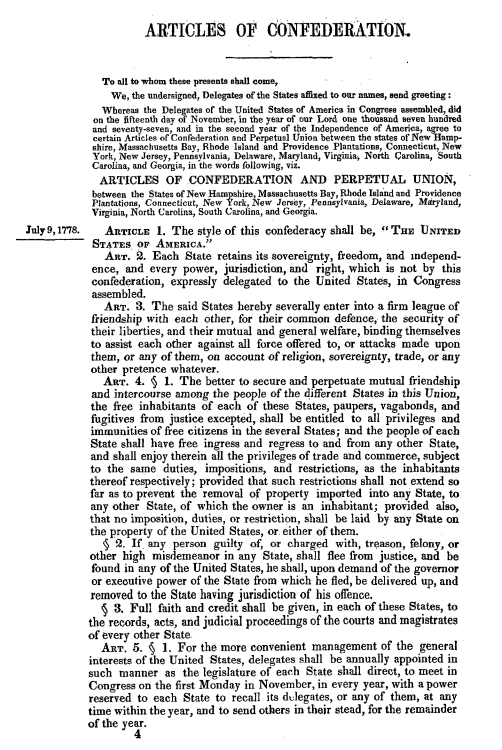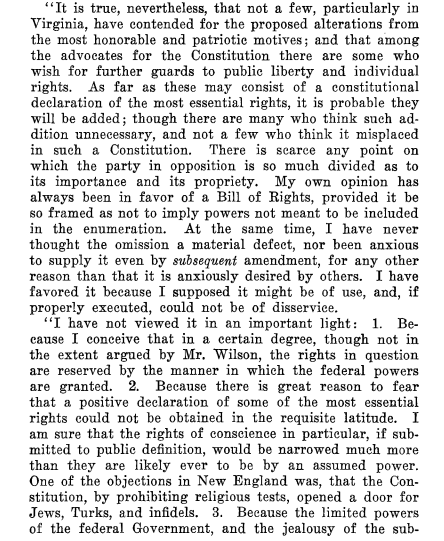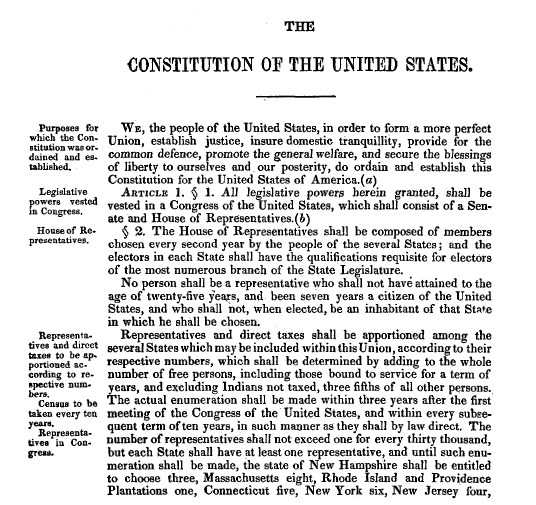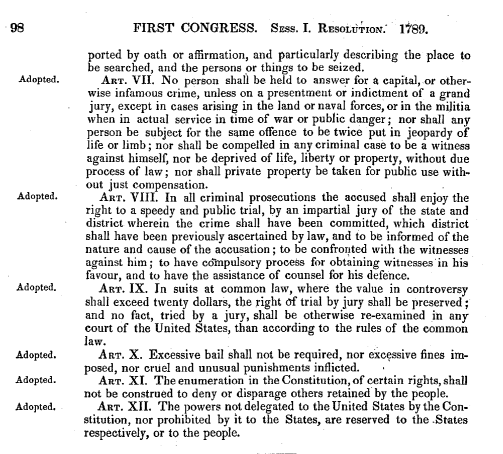December 15 marks Bill of Rights Day, commemorating the 1791 ratification of the first 10 amendments to the U.S. Constitution, collectively known as the Bill of Rights. Today, these rights—freedom of speech, freedom of religion, right to due process, right to a fair trial, etc.—are engrained in American culture as pillars of liberty and democracy. However, crafting a Bill of Rights was highly controversial at the time. James Madison, who drafted the amendments, didn’t even find them necessary, but some states refused to ratify the Constitution without a promise that a Bill of Rights would follow. Take a trip back to the early days of American history with us while we explore the creation and passage of the Bill of Rights using resources you can find in HeinOnline, particularly our World Constitutions Illustrated database!
The Failed Articles of Confederation
Before the Constitution, America was governed on the basis of the Articles of Confederation,[1]“Articles of Confederation,” U.S. Statutes at Large 20 : 1-756. This document can be found in HeinOnline’s World Constitutions Illustrated and U.S. Statutes at Large databases. which were established under the Continental Congress. The articles, ratified in 1777, were an agreement among the 13 states, formerly the 13 colonies, to establish the new country’s first federal government, based on a weak centralized government that consisted of only a legislative branch, with one house. However, the Articles of Confederation were doomed to fail—it was powerless to navigate conflict between the states, and because any proposed amendments had to be unanimously approved by all 13 states, it was virtually impossible to ratify anything. The federal government couldn’t tax, rally troops, or regulate commerce. A convention was called to address these failures, and thus the Constitutional Convention was born to establish a new governing system.

Federalists vs. Anti-Federalists
The Constitution[2]“The Constitution of the United States,” U.S. Statutes at Large 20 : 1-756. This document can be found in HeinOnline’s World Constitutions Illustrated and U.S. Statutes at Large databases. established a stronger centralized federal government with a system of checks and balances amongst three branches: legislative (House of Representatives and Senate), executive (the president), and judicial (the courts). Thirty-nine of the 55 delegates at the Convention signed off on this arrangement. However, many of those who didn’t, including George Mason[3]Paul Leicester Ford, Editor. Pamphlets on the Constitution of the United States. Published during its Discussion by the People 1787-1788 (1888). This document can be found in HeinOnline’s World Constitutions Illustrated database. and Edmund Randolph[4]Paul Leicester Ford, Editor. Pamphlets on the Constitution of the United States. Published during its Discussion by the People 1787-1788 (1888). This document can be found in HeinOnline’s World Constitutions Illustrated database. of Virginia and Elbridge Gerry[5]Paul Leicester Ford, Editor. Pamphlets on the Constitution of the United States. Published during its Discussion by the People 1787-1788 (1888). This document can be found in HeinOnline’s World Constitutions Illustrated database. of Massachusetts, refused to sign it without a Bill of Rights amended to it. In the wake of oppression from the English monarchy, Anti-Federalists, as they came to be called, feared excessive government power that could infringe on individual rights, and therefore wanted those rights specifically laid out. However, Federalists, such as James Madison,[6]David Kemper Watson. Constitution of the United States: Its History, Application and Construction (1910). This document can be found in HeinOnline’s World Constitutions Illustrated database. argued that the Constitution already limited the power of the government, and that to lay out specific rights would allow the government to restrict those not listed.

The Massachusetts Compromise
Several states ratified the Constitution as it was: Delaware, Pennsylvania, New Jersey, Georgia, and Connecticut. However, once it reached Massachusetts, John Hancock (governor with the famous signature) and Samuel Adams (lieutenant governor) would only agree to ratify the Constitution if amendments were proposed. Virginia and New York followed suit with similar demands. To settle the stalemate, a compromise was reached—the Anti-Federalists would support the ratification of the Constitution with the understanding that once the Constitution went into effect, a Bill of Rights would be created. With the Massachusetts Compromise,[7]Richard G. Wilkins, The Structural Role of the Bill of Rights, 6 BYU J. PUB. L. 525 (1992). This article can be found in HeinOnline’s Law Journal Library. Massachusetts voted to ratify the Constitution on February 6, 1788, and other states followed suit. With the necessary nine states voting to ratify, the new Constitution went into effect on March 4, 1789.

Drafting the Bill of Rights
Despite Madison’s hesitations with creating a Bill of Rights, he kept his promise and drafted an initial list of amendments, with inspiration from influential documents such as the English Bill of Rights of 1689,[8]Amos J. Peaslee. Constitutions of Nations (1950). This document can be found in HeinOnline’s Legal Classics database. the Magna Carta,[9]English text of the Magna Carta of 1215 1 (2010) The Charter of Liberties, or, The Great Charter, Granted by King John to His Subjects on the 15th Day of June, A.D. 1215. This document can be found in HeinOnline’s World Constitutions … Continue reading as well as Virginia’s Bill of Rights.[10]Francis (Compiler and Editor) Bowen. Documents of the Constitution of England and America, from Magna Charta to the Federal Constitution of 1789 (1854). This document can be found in HeinOnline’s Legal Classics database. The initial amendments were introduced on June 8, 1789. They were passed to the House of Representatives, which passed a joint resolution including 17 amendments. These were then sent to the Senate, which further edited them down to 12 amendments. A House-Senate Conference Committee was formed to resolve the discrepancies between the House and Senate amendment proposals, and on October 2, 1789, President Washington sent copies of the final 12 amendments to the states for ratification.
By December 15, 1791, three-fourths of the states had agreed to ratify amendments three through 12, and these 10 became our Bill of Rights.
The first proposed amendment,[11]Proposed Amendments not Ratified by the States, 1972 Const. U.S. 51 (1972). This document can be found in HeinOnline’s Legal Classics database. which would have altered the population system of representation in the House of Representatives, never came to pass, as it was never been ratified by enough states. The second amendment[12]Proposed Amendments not Ratified by the States, 1972 Const. U.S. 51 (1972). This document can be found in HeinOnline’s Legal Classics database. that didn’t pass in 1791, which required that any law adjusting compensation of congressional members could only be enacted after the next House of Representatives election, wasn’t ratified until 1992, and it is now the 27th (and most recent) amendment.[13]To amend title 38, United States Code, to establish a program to provide certain housing assistance to homeless veterans, to improve certain other programs that provide such assistance, and for other purposes., Public Law 102-590, 102 Congress. 106 … Continue reading
[A] bill of rights is what the people are entitled to against every government on earth, general or particular, and what no just government should refuse, or rest on inference.
The First 10 Amendments
In case you need a quick refresher, here are the rights guaranteed by each of the 10 amendments comprising the Bill of Rights:[14]Chapter 3, 1 Congress, Session 1, Resolution: ,” U.S. Statutes at Large 1 (1789): 97-98. This document can be found in HeinOnline’s World Constitutions Illustrated and U.S. Statutes at Large databases.
- Freedom of speech, freedom of press, freedom of religion, and freedom of assembly
- Right to keep and bear arms
- Restricts quartering of soldiers in private homes
- Protects against unreasonable search and seizure
- Protects against self-incrimination, being tried twice for the same offense, and from seizure of property without just compensation
- Right to an attorney and to a speedy public trial by an impartial jury
- Right to a trial by jury in federal civil cases where the claim exceeds a certain dollar amount
- Protection from excessive bail and fines, and from cruel and unusual punishment
- Clarifies that just because a right is not explicitly included in the Constitution, it doesn’t mean that it is not in effect
- Asserts that the federal government only has the powers designated in the Constitution—all other powers belong to the states or the people


Of course, over the years, many more amendments have been added to the constitution—we are currently at 27. But the rights granted in the Bill of Rights remain contentious. With the influx of mass shootings in the past few decades, the intention of the Second Amendment has come into question. The Supreme Court has seen cases where businesses deny service to LGBTQ+ couples based on their religion,[15]21-476 U.S. Reports 1 (2023) 303 Creative LLC et al. v. Elenis et al. This slip opinion can be found in HeinOnline’s U.S. Supreme Court Library. citing their First Amendment rights. Use of capital punishment is considered by opponents as “cruel and unusual punishment,” thereby violating the Eighth Amendment. The meaning of these amendments is subject to interpretation based on one’s perspectives and beliefs, which means that they will likely always be debated throughout the nation’s courts.
Consult the Constitution in HeinOnline
The U.S. Constitution and all of its amendments can be easily located within our World Constitutions Illustrated database, where you’ll also find the current constitution of every country in the world, as well as constitutional histories for each country, consisting of the constitution’s original text, amending laws, consolidated text, and important related texts. This database, edited by Jefri Jay Ruchti, is the most comprehensive online library for constitutional research. So celebrate Bill of Rights Day by exploring these important amendments in their original text within HeinOnline!
HeinOnline Sources[+]
| ↑1 | “Articles of Confederation,” U.S. Statutes at Large 20 : 1-756. This document can be found in HeinOnline’s World Constitutions Illustrated and U.S. Statutes at Large databases. |
|---|---|
| ↑2 | “The Constitution of the United States,” U.S. Statutes at Large 20 : 1-756. This document can be found in HeinOnline’s World Constitutions Illustrated and U.S. Statutes at Large databases. |
| ↑3, ↑4, ↑5 | Paul Leicester Ford, Editor. Pamphlets on the Constitution of the United States. Published during its Discussion by the People 1787-1788 (1888). This document can be found in HeinOnline’s World Constitutions Illustrated database. |
| ↑6 | David Kemper Watson. Constitution of the United States: Its History, Application and Construction (1910). This document can be found in HeinOnline’s World Constitutions Illustrated database. |
| ↑7 | Richard G. Wilkins, The Structural Role of the Bill of Rights, 6 BYU J. PUB. L. 525 (1992). This article can be found in HeinOnline’s Law Journal Library. |
| ↑8 | Amos J. Peaslee. Constitutions of Nations (1950). This document can be found in HeinOnline’s Legal Classics database. |
| ↑9 | English text of the Magna Carta of 1215 1 (2010) The Charter of Liberties, or, The Great Charter, Granted by King John to His Subjects on the 15th Day of June, A.D. 1215. This document can be found in HeinOnline’s World Constitutions Illustrated database. |
| ↑10 | Francis (Compiler and Editor) Bowen. Documents of the Constitution of England and America, from Magna Charta to the Federal Constitution of 1789 (1854). This document can be found in HeinOnline’s Legal Classics database. |
| ↑11, ↑12 | Proposed Amendments not Ratified by the States, 1972 Const. U.S. 51 (1972). This document can be found in HeinOnline’s Legal Classics database. |
| ↑13 | To amend title 38, United States Code, to establish a program to provide certain housing assistance to homeless veterans, to improve certain other programs that provide such assistance, and for other purposes., Public Law 102-590, 102 Congress. 106 Stat. 5136 (1992). This document can be found in HeinOnline’s World Constitutions Illustrated and U.S. Statutes at Large databases. |
| ↑14 | Chapter 3, 1 Congress, Session 1, Resolution: ,” U.S. Statutes at Large 1 (1789): 97-98. This document can be found in HeinOnline’s World Constitutions Illustrated and U.S. Statutes at Large databases. |
| ↑15 | 21-476 U.S. Reports 1 (2023) 303 Creative LLC et al. v. Elenis et al. This slip opinion can be found in HeinOnline’s U.S. Supreme Court Library. |



